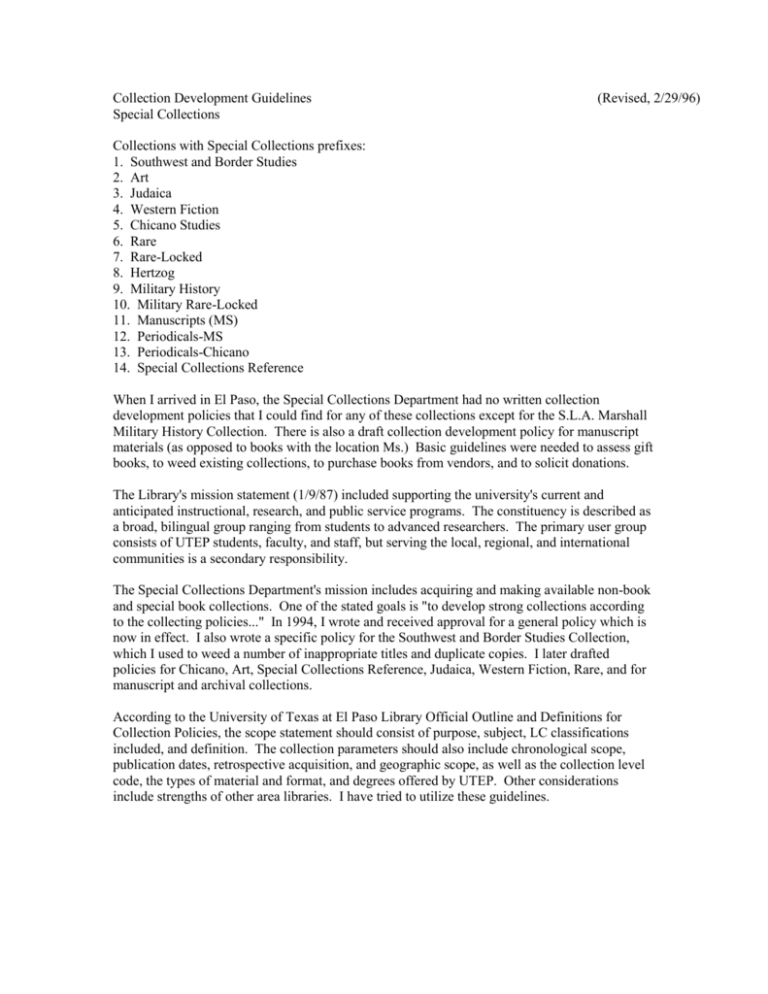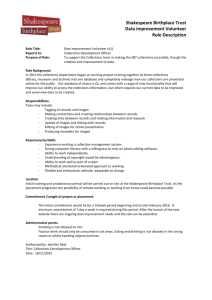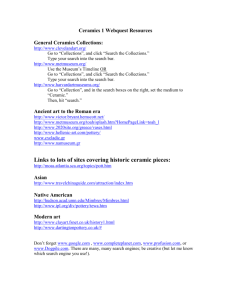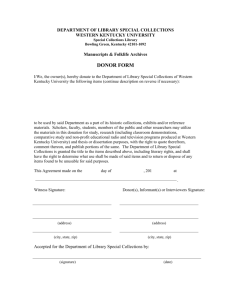Collection Development Guidelines (Revised, 2/29/96) Special
advertisement

Collection Development Guidelines Special Collections (Revised, 2/29/96) Collections with Special Collections prefixes: 1. Southwest and Border Studies 2. Art 3. Judaica 4. Western Fiction 5. Chicano Studies 6. Rare 7. Rare-Locked 8. Hertzog 9. Military History 10. Military Rare-Locked 11. Manuscripts (MS) 12. Periodicals-MS 13. Periodicals-Chicano 14. Special Collections Reference When I arrived in El Paso, the Special Collections Department had no written collection development policies that I could find for any of these collections except for the S.L.A. Marshall Military History Collection. There is also a draft collection development policy for manuscript materials (as opposed to books with the location Ms.) Basic guidelines were needed to assess gift books, to weed existing collections, to purchase books from vendors, and to solicit donations. The Library's mission statement (1/9/87) included supporting the university's current and anticipated instructional, research, and public service programs. The constituency is described as a broad, bilingual group ranging from students to advanced researchers. The primary user group consists of UTEP students, faculty, and staff, but serving the local, regional, and international communities is a secondary responsibility. The Special Collections Department's mission includes acquiring and making available non-book and special book collections. One of the stated goals is "to develop strong collections according to the collecting policies..." In 1994, I wrote and received approval for a general policy which is now in effect. I also wrote a specific policy for the Southwest and Border Studies Collection, which I used to weed a number of inappropriate titles and duplicate copies. I later drafted policies for Chicano, Art, Special Collections Reference, Judaica, Western Fiction, Rare, and for manuscript and archival collections. According to the University of Texas at El Paso Library Official Outline and Definitions for Collection Policies, the scope statement should consist of purpose, subject, LC classifications included, and definition. The collection parameters should also include chronological scope, publication dates, retrospective acquisition, and geographic scope, as well as the collection level code, the types of material and format, and degrees offered by UTEP. Other considerations include strengths of other area libraries. I have tried to utilize these guidelines. Collection Development Guidelines Special Collections (Revised, 6/20/95) I. Scope of Special Collections A. Purpose: To protect, preserve, and make available special book collections and non-book collections. Users include UTEP students, faculty, and staff, local community users, regional users, and researchers from other parts of the United States and foreign countries. Campus, local, and regional users are explicitly described as bilingual (English-Spanish). B. Subject: All subjects may be included in Special Collections. C. LC Classifications Included: A - Z and unclassified manuscript, photograph, sound, and vertical file materials. D. The primary themes are documenting UTEP, local and regional history, military history, Jewish culture and history, Mexican American culture and history, printing history and book design, world art, the Western fiction genre, and local writers, musicians, artists, and businesses. II. Collection Parameters A. Chronological Scope: Prehistory to present day. Special emphasis is placed on nineteenth and twentieth century material. Materials on Mexico and the Southwest may include information on the geology, archaeology, and prehistory of the area. B. Publication dates: Current dates are 1496-1993. Earlier hand-written documents may also be included. C. Retrospective acquisition: A large portion of new acquisitions may consist of older materials, especially if they relate to UTEP, El Paso, Juarez, far West Texas, Southern New Mexico, or Northern Chihuahua. D. Geographic Scope: Geographical areas emphasized are (in order of importance) UTEP, El Paso, Ciudad Juarez, far West Texas, Southern New Mexico, Northern Chihuahua, Texas as a whole or in part, Chihuahua, as a whole or in part, the new American Southwest as a whole or in part, Northern Mexico, as a whole or in part, the U.S.-Mexico border, the western United States, Mexico, Spain, Great Britain, Israel. Southwest and Border Studies Collection I. Scope of Southwest and Border Studies Collection A. Purpose: To support the University curriculum related to or with content regarding the Southwest, Border Studies, and Northern Mexico; to support research on local and regional issues by the University community, visiting scholars, and community users. Campus, local, and regional users are explicitly described as bilingual English-Spanish. B. Subject: All subjects which relate to the Southwest, Northern Mexico, and Border Studies, but primarily the history, social life, anthropology, and natural history of the area. C. LC classifications included: A - Z D. Works of academic research value will be acquired, especially those containing primary research materials. Works of fiction and literature will generally be acquired only if they relate strongly to the geographical area emphasized, either because of the regional importance of the author or because of regional content. E. In general, Special Collections will acquire only one copy of a book for the Southwest and Border Studies Collection; very popular books may justify 2 copies, or variant editions of the same book, if it is important. II. Collection Parameters A. Chronological Scope: Prehistory to present day. Special emphasis is placed on nineteenth and twentieth century material. Materials on Mexico and the Southwest may include information on the geology, archaeology, and prehistory of the area. B. Publication dates: Approximately 1840 to present. Earlier imprints will usually go into the RARE or RARE-L collections. C. Retrospective acquisition: A large portion of new acquisitions may consist of older materials, especially if they relate to UTEP, El Paso, Juarez, far west Texas, Southern New Mexico, or Northern Chihuahua. D. Geographic Scope: Geographical areas emphasized are (in order of importance) UTEP, El Paso, Ciudad Juarez, far west Texas, southern New Mexico, northern Chihuahua, Texas as a whole or in part, Chihuahua, as a whole or in part, the new American Southwest as a whole or in part, northern Mexico, as a whole or in part, the U.S.-Mexico border, the western United States, Mexico, and in some instances, Latin America or Mesoamerica as a whole. Materials relating to borders in general, no matter where, may be acquired. Judaica Collection I. Scope of Judaica Collection A. Purpose: To support the UTEP curriculum and student, staff, faculty, and community interest in Jews, Jewish culture and history. B. Subject: Jewish history, religion, art, and literature. Special emphasis is on Jews in El Paso, the American Southwest, Mexico, and Latin America. Because of the link with Spain and Latin America, Sephardic Jews are also a major topic. Because of research interests of faculty members, material on the European Holocaust of 1935-1945 and Jews in the Southern Cone of South America are also areas of collecting interest. C. LC classification numbers: A - Z, but primarily in the ranges of B, D, E, F, and P. D. Books of general interest are acquired, with the reading level usually within the general adult population level or undergraduate reading level. An emphasis is placed on reference works, first person accounts, and important popular works. No attempt is intended to document religious issues in great depth, although basic works are part of the collection. E. In general, Special Collections will keep only one copy of a book in the Judaica Collection; duplicate copies may be placed in the circulating MAIN collection. II. Collection Parameters A. Chronological Scope: Pre-history to the present day. B. Publication Dates: All dates. Books published before 1930 will be evaluated as possibilities for housing in the Rare collection, C. Retrospective Acquisition: Non-current books on Jewish history and culture may be added as donated or purchased from vendors. D. Geographical Scope: World-wide, with special emphasis on materials relating to Jews in El Paso and the Southwest or Northern Mexico. Materials on Jews in Mexico, the United States, Spain, Latin America, the Middle East, and Europe are acceptable. Western Fiction Collection I. Scope of the Collection A. Purpose: To support the University's academic programs, especially English courses, as well as student, staff, faculty and community interest in western fiction. B. Subject: Novels and short stories written in or about the American West, as well as literary criticism and bibliographies of Western Fiction. Although important novels in the Western genre are most clearly within the scope of the collection, any novels set in the west with a clearly western flavor may be acquired, including detective fiction, romances, and serious novels. C. LC Classification numbers: F, PQ, PR, PS D. Level of readership: General public E. Acquisition policies: Only one copy of any one edition of a title will be acquired, although multiple editions of the same title may be acquired with consideration of differences in text or illustration. II. Collection Parameters A. Chronological Scope: From European contact in the west (17th century) to present B. Publication dates: 1880-present C. Retrospective acquisition: Important or typical novels of the genre of Western Fiction may be added through purchase or gifts, especially if they relate to the El Paso area or to manuscript collections held in Special Collections D. Geographical scope: Texas, Oklahoma, New Mexico, Arizona, Nevada, Utah, California, and Northern Mexico, with materials relating to the El Paso area, far west Texas, and southern New Mexico given preference. Chicano Collection I. Scope A. Purpose: To support the academic programs at UTEP as well as interest of students, staff, faculty, and community users. Academic departments whose programs are supported by the Chicano Collection include Chicano Studies, Art, History, English, Theater Arts, Political Science, Languages and Linguistics, and Social Work. B. Subject: Mexican Americans in the United States, defined as those descendants of Spanish settlers already in the American West and Southwest when territories were annexed and Mexican immigrants to the United States since 1848. Some materials on Hispanic Americans in the United States may also be included, providing they refer to Mexican Americans specifically in the work. Any aspect of the culture and history of Mexican Americans may be treated, including politics, literature, cuisine, economic factors, and labor issues. C. LC Classification numbers: Almost any classification, but most books will be in the C, E, F, G, H, and P ranges. D. Level of readership and formats: Books for the general reading public, in English or Spanish, including scholarly or specialized works; reference works and serials. E. Acquisition policies: Generally, only one copy of each book will be added to the collection, although in cases of particularly popular or sought-after books, two copies may be acquired. II. Collection parameters A. Chronological scope: Seventeenth century to the present. B. Publication dates: Generally 1930s to present. C. Retrospective acquisition: Any book relating to Mexican Americans may be added if it is not part of the collection or a previously held copy has been damaged or lost. D. Geographical scope: Texas, New Mexico, Arizona, California, Illinois, or other states with Mexican American population. Mexico may be included if the books' subjects refer to immigration to the U.S. or cultural influences on Mexican-Americans. Special Collections Reference Collection Development Policy Statement (Draft) I. Scope of the collection A. Purpose: To support the academic programs at UTEP as well as research needs in Special Collections of students, staff, faculty, and community users. To support departmental needs for reference works needed to help patrons using the collections. B. Subject: Bibliographies, dictionaries, basic reference works relating to Texas, the Southwest, Mexico, and the U.S.-Mexico border region, directories of other archives and special collections departments, and works on preservation of manuscripts and library materials. C. LC classifications included: A-Z, but especially C, E, F, and Z. D. Works of to support academic research and professional staff needs will be acquired, especially those which assist in the location or utilization of primary research materials. E. Special Collections will acquire only one copy of each book needed for the SPC-Ref area; in some cases, both English and Spanish versions of the same title will be added. II. Collection Parameters A. Chronological Scope: Pre-history through the present, but primarily from the seventeenth century to the present. Bulk of the reference material is twentieth-century. B. Publication dates: 1850-present C. Retrospective acquisition: Bibliographies, guides, and other reference works should be evaluated carefully to assure that they are still valid. Dictionaries or almanacs of historical times may be added for use in interpreting older materials. D. Geographic Scope: United States, Mexico, and western Europe, especially Spain. Special Collections Art Collection Development Policy Statement I. Scope A. Purpose: To support the academic programs at UTEP as well as research needs and interests of students, staff, faculty, and community users, and to provide reference material on regional art and artists. Academic programs supported by the Special Collections Art Collection include studio art, art history, graphic design, theater arts, communications, archeology, and humanities. B. Subject: Art and the history of art, including fine arts, graphic arts, photography, architecture, jewelry, and costume. C. LC classifications included: A - Z, but predominantly N - NX, F, G - GR, and TR. D. Works of academic research value will be acquired, especially major illustrated reference works and works relating to art of the Southwestern United States and Mexico. E. In general, Special Collections will acquire only one copy of a book, although some very popular or frequently-assigned books may justify a second copy; the collection is intended as generally non-circulating, although all books circulate to faculty members, and some books circulate to any student, staff member, or community user with a valid card. Books or portfolios with loose plates or prints will be housed in Special Collections Art, as well as books on certain specified subjects designated by art faculty (i.e. jewelry). II. Collection Parameters A. Chronological Scope: Ancient times to the present, including art of pre-historic man and ancient civilizations as well as contemporary artists. B. Publication dates: 1900 - present. Usually art books older than twentieth-century materials will be housed in "Rare." C. Retrospective acquisition: Important works in good condition may be added, as well as replacement copies of books stolen, damaged, or mutilated. D. Geographic Scope: World-wide, including Western Europe, Asia, Africa, and the Americas, but especially materials on the art of the El Paso area, the American Southwest, and Mexico. Rare Books Collection Development Policy Statement I. Scope A. Purpose: To support the academic programs at UTEP as well as research needs and interest of students, staff, faculty, and community users. Academic departments whose programs are supported by the Rare Books department include English, History, Political Science, Nursing, Art History, and Performance Arts, especially Dance. B. Subject: Any subject, but specialized collections such as the Charles Motsch Dance Collection, the Sir Richard Francis Burton Collection, and the Nursing Collection provide indepth information on certain subjects. C. LC classifications included: A - Z, although sections on literature P - PS, and history F are among the largest sections. D. Works of academic research value will be acquired, especially those containing primary research materials. Books considered scarce by book dealers may be added, as may books from very limited editions, i.e. less than 500 copies. Books by local authors may be added regardless of scarcity to ensure a clean, uncirculated copy for reference and exhibits. E. In general, Special Collections will acquire only one copy of a book for its Rare collection, exceptions being inscribed or association copies, different editions of the same title which may be important because of textual, design, or illustration variations. II. Collection Parameters A. Chronological Scope: Ancient times - present. B. Publication dates: 1700 - present. C. Retrospective acquisition: Books of local interest, published in El Paso or other locations, may be added, as may books in fragile conditions transferred from other collections, important works of any nature which are too old or fragile to be added to circulating collections, but not available in current editions, and fine or typical examples of eighteenth- and nineteenth-century binding forms. D. Geographic Scope: World-wide, but especially relating to El Paso, the American Southwest, and northern Mexico. Materials relating to North America, Western Europe, Central America, and South America may also be added if they are otherwise acceptable. Draft 4/12/96 Policy for Collecting Archival Materials I. Scope A. Purpose: To support the mission of the Special Collections Department, University Library, and the University of Texas at El Paso by preserving and making available non-book materials relating to the University, El Paso, Cd. Juarez, and the diverse community within and surrounding it. The primary users are UTEP faculty and graduate students, as well as academic and independent researchers from the community or other universities. As a Regional Historical Resources Depository, Special Collections also accepts and preserves records of historical importance from county and local government agencies from several West Texas counties. Academic programs at UTEP which are supported by the manuscript collections include History, Political Science, English, Anthropology and Sociology, and Social Work. Faculty or graduate students in the fields of Nursing and Library Science also sometimes use the collections. B. Subject: Any subject which documents the El Paso-Ciudad Juárez region, or which is the subject of original research by faculty at the University. C. LC classifications included: LC classification numbers not used. D. Records of important or representative local businesses or organizations, papers of faculty members, papers of local residents and political figures are particularly sought. Also collected are materials documenting the arts and culture of the area, non-dominant political and social movements, and minority groups. Materials on mining, extractive industries, and railroads in the Southwest and Northern Mexico are especially sought, as well as photographic materials documenting the El Paso-Ciudad Juárez area. E. In general, the manuscript collections will not include published material or photocopies of published materials, except when it directly relates to the activities of the creator of the collection, i.e. copies of articles written by the creator and published in various journals, newspapers, etc. In some cases, subject files containing published materials may be retained, specifically if they document the creator's research or local topics. Generally only two copies, but not more than three identical copies of a document will be retained in a manuscript collection. Materials may be refused if they are offered with restrictive conditions, or if they are moldy or pest-infested. Acceptance of large collections may be limited by space considerations. II. Collection Parameters A. Chronological Scope: Any period, provided it has connections with the area. The bulk of the collections relate to the nineteenth or twentieth centuries, but material on the Spanish colonial past or pre-history may be included. B. Dates of generation of the materials: All periods, especially the time after European settlement of the area, i.e. 17th century-present. C. Retrospective acquisition: Special Collections both accepts and seeks materials documenting the past of the area. Since the Special Collections has only been collecting manuscript material since the 1960s, nearly all of the materials collected are retrospective in nature. D. Geographic Scope: Special Collections seeks materials which document the University of Texas at El Paso and its predecessor institutions, El Paso, Cd. Juárez, El Paso County, Distrito Bravos, far West Texas, Northern Chihuahua, Southern New Mexico, Chihuahua, Texas, the U.S.-Mexico border, the Southwestern United States, and Northen Mexico, in order of priority.









